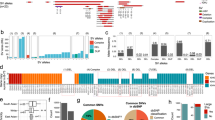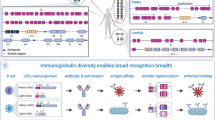Abstract
In the debate about the mechanism for the generation of immunological diversity, the initial positions of both 'somaticists' and 'germliners' were diametrically opposed. Then, as data developed favoring first one and then the other side, concessions were made, until the final solution showed that each had been at least partially correct.
This is a preview of subscription content, access via your institution
Access options
Subscribe to this journal
Receive 12 print issues and online access
$209.00 per year
only $17.42 per issue
Buy this article
- Purchase on Springer Link
- Instant access to full article PDF
Prices may be subject to local taxes which are calculated during checkout
Similar content being viewed by others
References
Capra, J.D. in The Generation of Antibody Diversity (ed. Cunningham, A.J.) 75 (Academic, New York, 1976).
However, Melvin Cohn suggests that it may be naive to conclude that here “everyone was a little bit right,” as thus everyone must have been a whole lot wrong—and it is from the latter that we learn. See Cohn, M. Annu. Rev. Immunol. 12, 41–42 (1994).
Pasteur, L. C. R. Acad. Sci. 90, 239–248 (1880).
Metchnikoff, E. Lectures on the Comparative Pathology of Inflammation (Keegan, Paul, Trench and Trübner, London, 1893). Reprinted by Dover (New York, 1968). See also Metchnikoff, E., Immunity in the Infectious Diseases (Macmillan, New York, 1905). Reprinted by Johnson Reprint (New York, 1968).
Ehrlich, P. Proc. R. Soc. Lond. 66, 424–448 (1900).
Obermayer, E. & Pick, E.P. Wien. klin. Wochenschr. 19, 327–333 (1906).
Pick, E.P. in Handbuch der pathogenen Mikroorganismen 2nd edn. Vol. 1 (ed. Kolle, W. & von Wassermann, A.) 685–868 (Fischer, Jena, 1912).
Landsteiner, K. The Specificity of Serological Reactions (Dover, New York, 1962), a reprint of the 1945 2nd edn.; the original German edition was published in 1933.
Max von Gruber had challenge Ehrlich on the size of the repertoire in Gruber, M. Münch. med. Wochenschr. 48, 1214–1215 (1901) and Gruber, M. Wien. klin. Wochenschr. 16, 791–793 (1903). A sign that Ehrlich's theory was in decline was the way that it was treated, as early as 1914, as “of historical interest” by Hans Zinsser in his Infection and Resistance (Macmillan, New York, 1914) and in W.W.C. Topley and G.S. Wilson's Principles of Bacteriology and Immunity 2nd edn. (William Wood, Baltimore, 1938).
Breinl, F. & Haurowitz, F. Z. Physiol. Chem. 192, 45–57 (1930).
Pauling, L. J. Am. Chem. Soc. 62, 2643–2657 (1940).
The role of darwinian ideas in immunological theory is outlined in Silverstein, A.M. Nat. Immunol. 4, 3–6 (2003).
Jerne, N.K. Proc. Natl. Acad. Sci. USA 41, 849–857 (1955).
Burnet, F.M. Austr. J. Sci. 20, 67–69 (1957). David Talmage had arrived independently at a similar idea of selection in Annu. Rev. Med. 8, 239–256 (1957).
Burnet, F.M. The Clonal Selection Theory of Antibody Formation (Cambridge University Press, London, 1959).
Lederberg, J. Science 129, 1649–1653 (1959).
Talmage, D.W. Science 129, 1643–1648 (1959). See also Titani, K., Whitley, E., Avogardo, L. & Putnam, F.W. Science 152, 1513–1516 (1965).
This argument was advanced in Hood, L. & Talmage, D.W. Science 168, 325–334 (1970) in the context of two genes, not for entire light or heavy chains, but for their respective variable regions. They would calculate that no more than 0.2% of the total DNA in the genome would suffice.
Klinman showed that as many as 5,000 different clonotypes reactive with the dinitrophenyl group could be found in the mouse, in Klinman, N.R. J. Exp. Med. 136, 241–260 (1972) and Sigal, N.H. & Klinman, N.R. Adv. Immunol. 26, 255–337 (1978), and Kreth and Williamson calculated that the mouse can produce some 8,000–15,000 individual clones reactive with the o-nitro-p-iodophenyl (NIP) hapten, in Kreth, H.W. & Williamson, A.R. Eur. J. Immunol. 3, 141–146 (1973). See also Pink, J.R.L. & Askonas, B. Eur. J. Immunol. 4, 426–430 (1974).
According to Hood, L. & Prahl, J. Adv. Immunol. 14, 291–351 (1971), a new antibody gene develops by a slow process of mutation and selection in evolutionary time.
Kindt, T.J. & Capra, J.D. The Antibody Enigma (Plenum, New York, 1984). These authors present in detail all of the data (except for the ontogenetic data) that contributed to the original debate and then to the ultimate molecular biological solution to the problem of the generation of diversity.
See, for example, Cohn, M. Cell. Immunol. 1, 461–467 (1970) and Jerne, N.K. Ann. Inst. Pasteur 125C, 373–389 (1974).
However, Melvin Cohn, in Cell. Immunol. 1, 461–467 (1970), calculated that there is indeed enough time.
Brenner, S. & Milstein, C. Nature 211, 242–243 (1966).
Smithies, O. Science 157, 267–273 (1967) and Smithies, O. Nature 199, 1231–1236 (1963). See also Smithies, O. Cold Spring Harb. Symp. Quant. Biol. 32, 161–166 (1967).
Edelman, G.M. & Gally, J.A. Proc. Natl. Acad. Sci. USA 57, 353–358 (1967).
See šterzl, J. & Silverstein, A.M. Adv. Immunol. 6, 337–459 (1967) and Solomon, J.B. Foetal and Neonatal Immunology (North Holland, Amsterdam, 1971).
Thus, the tadpole does reasonably well with fewer than one million lymphocytes: Du Pasquier, L. Immunology 19, 353–362 (1970); Du Pasquier, L. & Wabl, M.R. in The Generation of Antibody Diversity (ed. Cunningham, A.J.) 151–164 (Academic, New York, 1976). The very young fetal lamb does equally well: Silverstein, A.M. & Prendergast, R.A. in Developmental Aspects of Antibody Formation and Structure Vol. I (eds. šterzl, J. & Řiha, I.) 69–77 (Czech Academy of Sciences, Prague, 1970).
Thus, the fetal lamb, in Silverstein, A.M. & Prendergast, R.A. in Developmental Aspects of Antibody Formation and Structure Vol. I (eds. šterzl, J. & Řiha, I.) 69–77 (Czech Academy of Sciences, Prague, 1970); the mouse, in Yung, L. et al. Eur. J. Immunol. 3, 224–228 (1973); and the opossum, in Sherwin, W.K. & Rowlands, D.T. J. Immunol. 113, 1353–1360 (1974). These data were used to argue in favor of the germline side of the multigene/paucigene debate by Silverstein, A.M. in Phylogenic and Ontogenic Study of the Immune Response and its Contribution to the Immunological Theory (eds. Liacopoulos, P & Panijel, J.) 221–227 (INSERM, Paris, 1973).
Klinman, N.R., Press, J.L., Sigal, N.H. & Gearhart, P.J. in The Generation of Antibody Diversity (ed. Cunningham, A.J.) 127–149 (Academic Press, New York, 1976); Klinman, N.R. et al. Cold Spring Harb. Symp. Quant. Biol. 41, 165–173 (1976).
Such a theory of antigen-enhanced generation of diversity was advanced by Cunningham, A.J. & Pilarsky, L.M. Scand. J. Immunol. 3, 5–10 (1974).
Porter, R.R. Biochem. J. 46, 479–484 (1950); Fried, M. & Putnam, F.W. J. Biol. Chem. 193, 1086–1087 (1960); Nisonoff, A., Wissler, F.C. & Woernley, D.L. Biochem. Biophys. Res. Commun. 1, 318–322 (1959).
Edelman, G.M. J. Am. Chem. Soc. 81, 3155–3156 (1959); Fraňek, F. Biochem. Biophys. Res. Commun. 4, 28–32 (1961).
Slater, R.J., Ward, S.M. & Kunkel, H.G. J. Exp. Med. 101, 85–108 (1955); Kunkel, H.G. Harvey Lect. 59, 219–242 (1965). Potter's discovery that myelomas can be induced in mice by intraperitoneal injection of mineral oil provided extensive material for sequencing: Potter, M. & Boyce, C. Nature 193, 1086–1087 (1962) and Potter, M. Physiol. Rev. 52, 631–719 (1972).
Edelman, G.M. & Gally, J.A. J. Exp. Med. 116, 207–227 (1962); see also Putnam, F.W. & Hardy, S. J. Biol. Chem. 212, 361–369 (1955).
Hilschmann, N. & Craig, L.C. Proc. Natl. Acad. Sci. USA 53, 1403–1409 (1965); Putnam, F.W. et al. Cold Spring Harb. Symp. Quant. Biol. 32, 9–29 (1967).
Dreyer, W.J. & Bennet, J.C. Proc. Natl. Acad. Sci. USA 54, 864–869 (1965).
Wu, T.T. & Kabat, E.A. J. Exp. Med. 132, 211–250 (1970).
Kehoe, J.M. & Capra, J.D. Proc. Natl. Acad. Sci. USA 68, 2019–2021 (1971).
A variant of this gene segment idea was taken up by Capra, J.D. & Kindt, T.J. Immunogenetics 1, 417–427 (1975).
Hood, L. & Talmage, D.W. Science 168, 325–334 (1970).
Fitch, W.M. & Margoliash, E. Science 155, 279–284 (1967).
See Weigert, M.G. et al. Nature 228, 1045–1047 (1970).
Oudin, J. C. R. Acad. Sci. 242, 2606–2608 (1956). See also Grubb, R. Acta Pathol. Microbiol. Scand. 39, 195–197 (1956).
Todd, C.W. Biochem. Biophys. Res. Commun. 11, 170–175 (1963); Feinstein, A. Nature 199, 1197–1199 (1963).
Pernis, B. et al. J. Exp. Med. 122, 853–876 (1965); Weiler, E. Proc. Natl. Acad. Sci. USA 54, 1765–1772 (1965).
Oudin, J. & Michel, M. C. R. Acad. Sci. 257, 805–808 (1963); Kunkel, H.G., Mannick, M. & Williams, R.C. Science 140, 1218–1219 (1963); Gell, P.G.H. & Kelus, A. Nature 201, 687–689 (1964).
Kuettner, M.G., Wang, A. & Nisonoff, A. J. Exp. Med. 135, 579–595 (1972).
Eichmann, K. Eur. J. Immunol. 2, 301–307 (1972).
Lieberman, R. et al. J. Exp. Med. 139, 983–1001 (1974).
See, for example, Eichmann, K. & Kindt, T.J. J. Exp. Med. 134, 532–552 (1971) and Eichmann, K. Immunogenetics 2, 491–506 (1975).
The history of the cellularist/humoralist debate is described in Silverstein, A.M. Cell. Immunol. 48, 208–221 (1979).
See, for example, Cantor, H., Chess, L. & Sercarz, E. (eds.) Regulation of the Immune System (Alan Liss, New York, 1984) and Bock, G.R. & Goode, J.A. (eds.) Immunological Tolerance (Wiley, New York, 1997). In his introduction to the latter volume, Avrion Mitchison concludes (on page 4), “The problem posed by Ehrlich turns out to be far, far more complex than the pioneers had imagined.”
See, for example, Delovitch, T.L. & Baglioni, C. Proc. Natl. Acad. Sci. USA 70, 173–178 (1973); Premkumar, E., Shoyab, M. & Williamson, A.R. Proc. Natl. Acad. Sci. USA 71, 99–103 (1974); Leder, P. et al. Proc. Natl. Acad. Sci. USA 71, 5109–5114 (1974); Tonegawa, S. et al. FEBS Lett. 40, 92–96 (1974).
Leder, P. Sci. Am. 246, 102–115 (1982).
Tonegawa, S. et al. Cold Spring Harb. Symp. Quant. Biol. 41, 877–889 (1976).
Weigert, M. et al. Nature 276, 785–790 (1978).
For a full review of the molecular genetics of immunoglobulin formation, see Max, E.E. in Fundamental Immunology 4th edn. (ed. Paul, W.E.) 111–182 (Lippincott-Raven, New York, 1998).
See Langman, R.E. & Cohn, M. Semin. Immunol. 14, 153–162 (2002).
For example, Cohn, M., Langman, R.E. & Geckeler, W. Progr. Immunol. 4, 153–201 (1980); Janeway, C.A. Immunol. Today 13, 11–16 (1992). Briles and colleagues have been more specific, suggesting that the germline contains genes encoding the antibody of the T15 idiotype specific for the ubiquitous bacterial component phosphoryl choline, in Briles, D.E. et al. Exp. Med. 156, 1177–1185 (1982).
Langman, R.E. & Cohn, M. Mol. Immunol. 24, 675–697 (1987). They suggested that the problem of natural selection is simpler, in that the critical germline specificities maintained by selection are formed by the unique pairing of the germline VH and VL segments.
Ohno, S. Perspect. Biol. Med. 19, 527–532 (1976) and Ohno, S. Progr. Immunol. 4, 577–598 (1980).
Author information
Authors and Affiliations
Rights and permissions
About this article
Cite this article
Silverstein, A. Splitting the difference: the germline–somatic mutation debate on generating antibody diversity. Nat Immunol 4, 829–833 (2003). https://doi.org/10.1038/ni0903-829
Issue Date:
DOI: https://doi.org/10.1038/ni0903-829
This article is cited by
-
Stems and Standards: Social Interaction in the Search for Blood Stem Cells
Journal of the History of Biology (2010)



